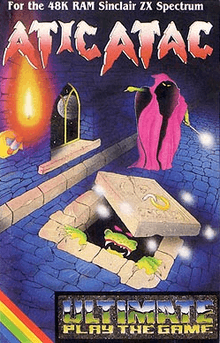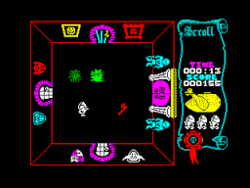Atic Atac
Atic Atac is an arcade-adventure video game developed and published by Ultimate Play the Game, released for the ZX Spectrum and the BBC Micro in 1983. The game takes place within a castle in which the player must seek out the "Golden Key of ACG"[lower-alpha 1] by unlocking doors and avoiding enemies. It was Ultimate's second game to require 48K of RAM; most of their previous games for the Spectrum ran on unexpanded 16K models.
| Atic Atac | |
|---|---|
 ZX Spectrum cover art | |
| Developer(s) | Tim and Chris Stamper |
| Publisher(s) | Ultimate Play the Game |
| Platform(s) | ZX Spectrum BBC Micro |
| Release | ZX Spectrum
|
| Genre(s) | Arcade adventure Maze |
| Mode(s) | Single-player |
The game was written by Tim Stamper and its graphics were designed by Chris Stamper. Atic Atac received praise from critics upon release, mostly for its graphics and gameplay. It was later included in Rare's 2015 Xbox One retrospective compilation, Rare Replay. The game served as inspiration for the critically acclaimed adventure game show Knightmare.
Gameplay

The game is presented in a top-down perspective and is set inside a labyrinth of a complex castle. The player has been trapped inside and needs to collect three pieces of the "Golden Key of ACG" in order to escape. They can choose from three different characters; a Wizard, Knight or Serf.[2][3] Each character has a different weapon to kill common enemies and access to a secret passage unique to them, meaning that navigating the castle is different for each one.[4][5]
There are a number of items scattered around the castle, of which the player may carry up to three at a time. Some of these are always in the same place at the start of the game, whereas others are distributed randomly.[4] Items include differently-coloured keys which will unlock their respective doors, the three pieces of the ACG key, and other items that affect certain enemies or are mere red herrings.[2] Common enemies appear in each room upon entering and will attack the player on sight. Collision with these enemies destroys them but drains a portion of the player's health. There are also stationary poisonous fungi which will drain health constantly if the player is in contact with them, and enemies that require special items in order to either distract, repel or kill them, otherwise they remain in the room, invulnerable to conventional attacks, and rapidly drain the player's health if touched.[3]
The player has three lives upon starting the game, and should they die a gravestone will appear at their location and stay in place for the remainder of the current game.[4] Health can be replenished by collecting food scattered throughout the castle, however it will constantly drop the more the player moves, thus the player may eventually lose a life from starvation if they have not escaped the castle in time.[2]
Development
Ultimate Play the Game was founded by brothers Tim and Chris Stamper, along with Tim's wife, Carol, from their headquarters in Ashby-de-la-Zouch in 1982. Under the trading name of Ultimate Play the Game, they began producing multiple video games for the ZX Spectrum throughout the early 1980s.[6] Prior to founding Ultimate, the Stamper brothers had backgrounds in designing arcade machines, but no marketing experience in the video game sector.
The operations of Ultimate were secretive and the Stamper brothers rarely gave interviews.[6][7] Computer and Video Games noted that during development of Atic Atac, staff would work in "separate teams" to ensure quality control; one team would work on graphics whilst the other would oversee gameplay or sound.[2] The Stamper brothers worked seven days a week with little sleep in order to devote more time into developing video games, and would frequently re-use the same mechanics of their earlier games into newer ZX Spectrum games.[6]
Reception and legacy
| Reception | ||||||||||
|---|---|---|---|---|---|---|---|---|---|---|
| ||||||||||
The game received a positive critical reception upon release. Micro Adventurer mainly praised Ultimate's capabilities of developing high quality games, saying that Atic Atac was "bound to fix their name firmly into the minds of adventurers", further recommending the game "without reservation".[7] Crash enjoyed the game's colourful graphics, heralding the detail and objects of the game to be "marvellous". However, they criticised the difficult joystick control and vague instructions, adding that the entire game is a "learning experience".[8] Computer and Video Games stated that the game was "the best yet from Ultimate",[4] and later in 1984 described it as "the favourite arcade adventure amongst computer gamesters".[2] Personal Computer Games wrote that it was "another blockbuster game",[10] while Sinclair User praised both the depth of plot and the advanced graphics, citing them both as "superb".[11]
In 1991, Atic Atac was ranked as the 79th best ZX Spectrum game of all time by Your Sinclair,[12] and was voted the 8th best game of all time by the readers of Retro Gamer Magazine for an article that was scheduled to be in a special Your Sinclair Tribute issue.[13] In 2007, Eurogamer described it as a prime example of "what passion can do when properly digitised".[14] The game was Ultimate's third consecutive number one in the UK Spectrum sales chart,[15] following the first two Jetman games. In 2015, the game was included in Rare Replay, a collection of 30 Rare-designed games released for the Xbox One gaming console.[16]
The game was a major inspiration for the critically acclaimed CITV game show Knightmare, with producer Tim Child realising that if a ZX Spectrum could run a compelling adventure game, then a television programme with pre-rendered graphics could revolutionise the genre.[17][18] Sabre Wulf, which was released for the ZX Spectrum by Ultimate Play the Game later in 1984, was noted for having similar gameplay to Atic Atac, including its similar themes of a continuous maze.[3] In a retrospective interview with Retro Gamer, Rare designer Greg Mayles asserted that their 2003 game Grabbed by the Ghoulies was not inspired by Atic Atac, despite their similar themes of a haunted mansion.[19]
Notes
- "ACG" is an acronym for Ultimate Play the Game's trading name, Ashby Computers and Graphics Ltd.
References
- "Atic Atac - Sinclair ZX Spectrum release year". IGN. Retrieved 9 August 2015.
- "Attack Atic Atac". Computer and Video Games (34): 53–59. August 1984.
- Fox, Matt (2013). The video games guide : 1,000+ arcade, console and computer games, 1962-2012 (2nd ed.). Jefferson, N.C.: McFarland & Company, Inc., Publishers. ISBN 978-0-7864-7257-4.
- "You'll be haunted by Atic Atac". Computer and Video Games (28): 31–32. February 1984.
- "Ultimate Play the Game". The BBC Games Archive. Archived from the original on 20 October 2007. Retrieved 2007-10-07.
- "The Best of British - Ultimate". Crash. Retrieved 13 August 2015.
- "Hybrid wins the accolades". Micro Adventurer (3): 28. January 1984.
- "Atic Atac". CRASH (2): 34. March 1984. Archived from the original on 26 September 2007. Retrieved 2007-10-06.
- Spencer, Spanner (10 October 2007). "Atic Atac review - Eurogamer". Eurogamer. Retrieved 9 August 2015.
- "Video horrorshow". Personal Computer Games (3): 4. February 1984.
- "Dangerous castle is highly recommended". Sinclair User (23): 52. February 1984. Archived from the original on 12 September 2007. Retrieved 2007-10-06.
- "Top 100 Speccy Games", Your Sinclair, Future plc (70): 31–33, October 1991 Alt URL
- "The 50 Best Speccy Games Ever!". ysrnry.co.uk. November 2004. Archived from the original on 2015-09-12.
- Spencer, Spanner (2007-10-10). "Atic Atac". Eurogamer. Retrieved 2007-10-30.
- "Chart Toppers", C+VG, Future Publishing (28): 163, February 1984
- "Rare Celebrates Its 30th Anniversary with a Massive 30-Game Collection". Xbox News. 15 June 2015. Retrieved 19 August 2015.
- "A Man Walks Into a Bar... Tim Child". Bother's Bar. Retrieved 17 March 2010.
- "The History of Knightmare". Knightmare. Archived from the original on 8 June 2009. Retrieved 10 August 2015.
- "A Rare Glimpse". Retro Gamer. No. 84. December 2010. p. 38.
External links
- Atic Atac can be played for free in the browser at the Internet Archive
- Atic Atac at MobyGames
- Atic Atac at SpectrumComputing.co.uk